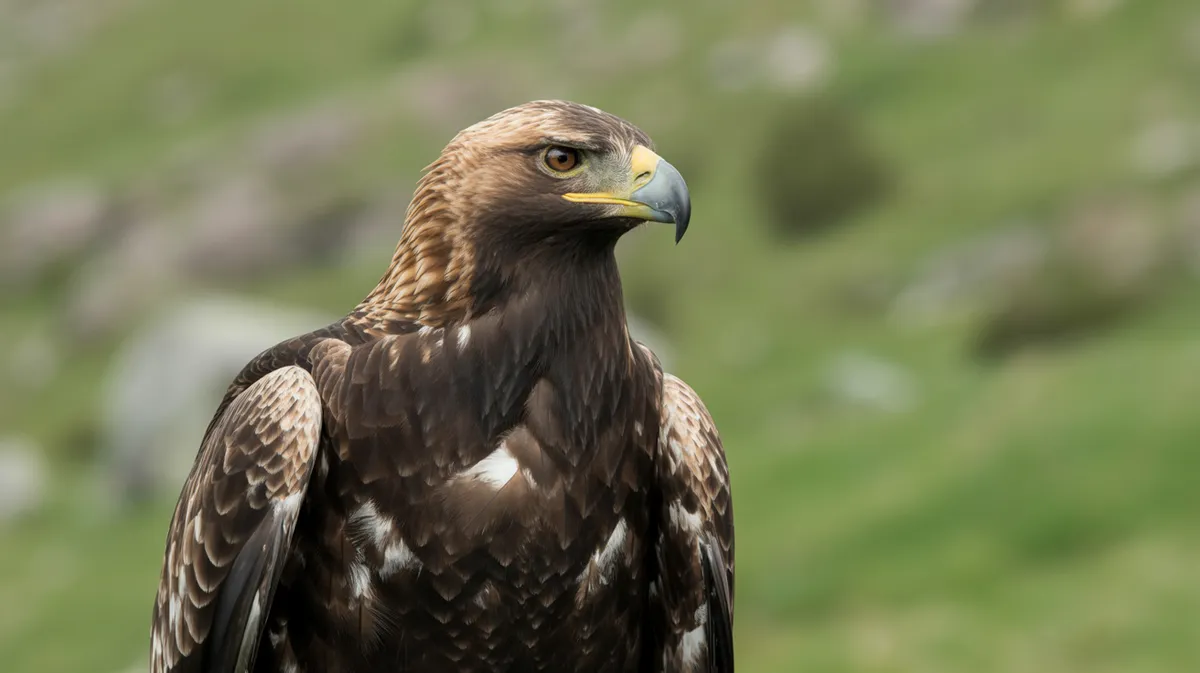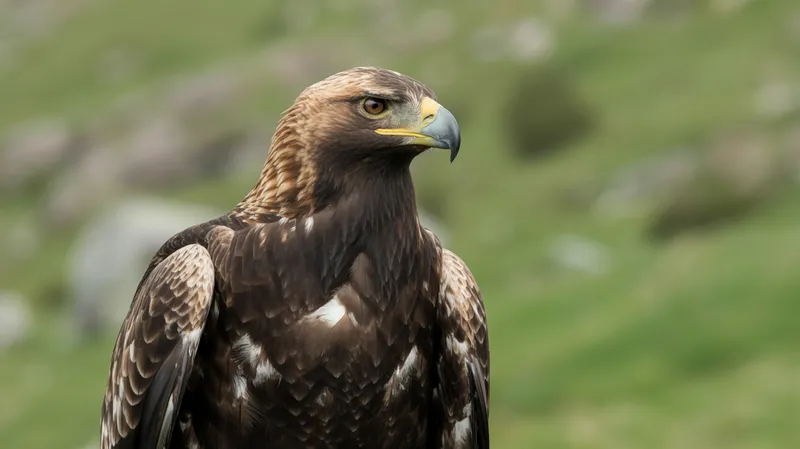
Golden Eagle
Aquila chrysaetos

Meet the Golden Eagle
The Golden Eagle is one of the largest and most powerful raptors in the Northern Hemisphere, renowned for its striking golden-brown plumage and piercing eyes. It soars effortlessly over mountains, plateaus, and open landscapes, using its exceptional eyesight to spot prey from great heights. This bird of prey is known for its agility and strength, able to capture mammals as large as hares and even young deer. Golden Eagles are highly territorial and monogamous, often returning to the same nesting sites year after year.
Classification
Bird
Habitat
Mountains and open uplands
Diet
Carnivore
Lifespan
15-30 years in the wild
Conservation
Least Concern
Weight
3.0–6.5 kg (6.6–14.3 lbs)
📖Fascinating Facts
Powerful Hunter
Golden Eagles hunt a wide range of prey, including rabbits, ground squirrels, marmots, and sometimes even large birds and foxes.
Mountain Dweller
They prefer rugged, open habitats such as mountains, plateaus, and steppes, where they can hunt and nest with minimal disturbance.
Exceptional Vision
Golden Eagles possess extraordinary eyesight that allows them to spot small mammals from over a mile away.
📋Detailed Description
The Golden Eagle (Aquila chrysaetos) is a large, robust raptor with a wingspan typically ranging from 180 to 234 cm (5 ft 11 in to 7 ft 8 in) and a body length of 66 to 102 cm (26–40 in), making it one of the largest birds of prey in the Northern Hemisphere. Adults exhibit dark brown plumage with a distinctive golden sheen on the nape and crown, while juveniles display prominent white patches at the base of the tail and on the wings. The beak is powerful and hooked, suited for tearing flesh, and the feet are equipped with formidable talons capable of exerting a grip force exceeding 400 psi. Golden Eagles possess exceptional eyesight, estimated to be 4–8 times sharper than that of humans, allowing them to spot prey from several kilometers away. They are highly territorial, often occupying vast home ranges that can exceed 200 km², and are known for their aerial agility and soaring flight, utilizing thermal currents to conserve energy. Socially, they are generally solitary or found in monogamous pairs, with both sexes participating in territory defense and nest maintenance. Nests, or eyries, are massive structures built on cliffs or large trees and are reused and added to over many years, sometimes reaching over 2 meters in diameter. The species is long-lived, with wild individuals often surviving 15–30 years, and some captive birds exceeding 40 years. Their ecological role as apex predators helps regulate populations of medium-sized mammals and birds, contributing to ecosystem balance.
💡 Did you know?
In some cultures, Golden Eagles have been trained for traditional hunting, especially in Central Asia, where they help hunt foxes and other animals.
🔬Research & Sources
Wikipedia Summary
The golden eagle is a bird of prey living in the Northern Hemisphere. It is the most widely distributed species of eagle. Like all eagles, it belongs to the family Accipitridae. They are one of the best-known birds of prey in the Northern Hemisphere. These birds are dark brown, with lighter golden-brown plumage on their napes. Immature eagles of this species typically have white on the tail and often have white markings on the wings. Golden eagles use their agility and speed combined with powerful feet and large, sharp talons to hunt a variety of prey, mainly hares, rabbits, and marmots and other ground squirrels. Golden eagles maintain home ranges or territories that may be as large as 200 km2 (77 sq mi). They build large nests in cliffs and other high places to which they may return for several breeding years. Most breeding activities take place in the spring; they are monogamous and may remain together for several years or possibly for life. Females lay up to four eggs, and then incubate them for six weeks. Typically, one or two young survive to fledge in about three months. These juvenile golden eagles usually attain full independence in the fall, after which they wander widely until establishing a territory for themselves in four to five years.
Last Modified: 5/22/2025
🎭Behavior & Social Structure
Golden Eagles are diurnal hunters, most active during the day, particularly in the early morning and late afternoon. They employ a combination of soaring and perch-hunting, using their keen vision to detect prey such as hares, rabbits, ground squirrels, marmots, and occasionally larger animals like young ungulates. Hunting strategies include high-speed stoops, low contour flights, and cooperative hunting in pairs, especially during the breeding season. They are known for their remarkable agility in flight, capable of rapid dives at speeds exceeding 240 km/h (150 mph). Social interactions are primarily limited to mated pairs and their offspring, with territorial disputes involving elaborate aerial displays and vocalizations. Outside the breeding season, juveniles and subadults may form loose associations, but adults remain fiercely territorial. Golden Eagles spend significant time preening, sunning, and maintaining their plumage, which is essential for insulation and flight efficiency.
👶Reproduction & Life Cycle
Golden Eagles are monogamous, often forming lifelong pair bonds. Courtship involves spectacular aerial displays, including mutual soaring, talon locking, and cartwheeling dives. Breeding typically occurs from late winter to early spring, with egg-laying varying by latitude and altitude. Females lay 1–4 eggs (most commonly 2), which are incubated primarily by the female for 41–45 days. The male provides most of the food during incubation. After hatching, chicks are altricial and require intensive parental care; siblicide (the death of the younger chick due to aggression from an older sibling) is common when food is scarce. Both parents feed the young, which fledge at 65–75 days but remain dependent for several weeks to months. Juveniles disperse widely after independence and reach sexual maturity at 4–5 years.
🛡️Adaptations & Survival
Golden Eagles exhibit a suite of adaptations for predation and survival in diverse habitats. Their large, broad wings and long tail facilitate soaring and maneuverability in mountainous and open terrain. Dense, insulating plumage allows them to withstand cold temperatures at high altitudes. Their powerful legs and talons are specialized for grasping and killing prey, while the hooked beak efficiently tears flesh. Exceptional visual acuity enables detection of small animals from great distances. Behavioral adaptations include caching surplus food and using updrafts for energy-efficient flight. Their ability to exploit a wide range of prey and habitats has contributed to their extensive distribution.
🎨Cultural Significance
The Golden Eagle holds profound cultural and symbolic importance across the Northern Hemisphere. Revered in many indigenous cultures, it is a sacred animal in Native American traditions, often associated with power, courage, and spiritual guidance. In ancient Rome, the eagle was a symbol of imperial authority, while in modern times, it serves as a national emblem for countries such as Kazakhstan, Mexico, and Albania. Feathers and imagery of the Golden Eagle are used in rituals, heraldry, and national insignia, reflecting its status as a symbol of strength and freedom.
🔬Recent Research & Discoveries
Recent research on Golden Eagles has focused on their movement ecology using satellite telemetry, revealing extensive dispersal and migration patterns, especially among juveniles. Studies have highlighted the species' sensitivity to wind energy infrastructure, prompting the development of mitigation strategies such as turbine curtailment and power line retrofitting. Genetic analyses have clarified subspecies relationships and population structure, supporting conservation planning. Ongoing studies are investigating the impacts of climate change on breeding phenology and prey dynamics. Long-term monitoring projects in North America and Eurasia continue to provide valuable data on population trends and reproductive success.
🎥Wildlife Videos

The Golden Eagle - Master of the Sky | Free Documentary Nature
The Golden Eagle - Master of the Sky | Wildlife Documentary Watch 'Germany's Wild Birds' here: https://youtu.be/RpgWh3udd-A ...
Free Documentary - Nature

The Golden Eagle - Kings of the Alps | Free Documentary Nature
The Golden Eagle - Kings of the Alps | Wildlife Documentary Watch: "Eagles: The Kings of the Sky" here: ...
Free Documentary - Nature

THE SWISS ALPS | Secrets of the Apex Hunters | Animal documentary
Welcome to the majestic Swiss Alps, a breathtaking wilderness that's home to some of the most extraordinary apex predators on ...
WILD NATURE - Nature animal documentary

WATCH A GOLDEN EAGLE HUNTING FOR DEER
https://outdoors-international.com - Did you know that an eagle can kill a deer? Watch this eagle hunting deer. Impressive!
Outdoors International

The Golden Eagle Under Attack: The Battle Against Millions of Bees
wildliferescue #animalrescue #goldeneaglerescue A majestic golden eagle finds itself in grave danger when a swarm of wild ...
All Things Wild

Eagles: The Kings of the Sky | Free Documentary Nature
Eagles: The Kings of the Sky | Free Wildlife Documentary Watch: "The Golden Eagle: King of the Mountains" here: ...
Free Documentary - Nature
🌍Habitat Information
The Golden Eagle typically inhabits Mountains and open uplands environments. Golden Eagles have adapted to their environments with specialized features and behaviors.
Primary Habitat:
Mountains and open uplands
More detailed habitat information will be available soon.
🛡️Conservation Status
The Golden Eagle is currently classified as Least Concern. Conservation efforts are crucial for preserving this species for future generations.
Common Threats:
- 🏠Habitat loss and fragmentation
- 🌡️Climate change impacts
- 🎯Hunting and poaching
- 🏭Human-wildlife conflict
⚠️Threats & Conservation Challenges
While the Golden Eagle is classified as Least Concern globally, regional populations face significant threats. Habitat loss due to agriculture, urbanization, and energy development (especially wind turbines and power lines) poses risks of collision and electrocution. Persecution through illegal shooting, poisoning, and trapping persists in some areas, often due to perceived threats to livestock. Declines in prey populations, particularly lagomorphs and ground squirrels, can impact breeding success. Climate change may alter habitat suitability and prey availability. Conservation measures include legal protection, habitat management, and mitigation of human-wildlife conflict, but ongoing monitoring is essential to detect emerging threats.
🔬Scientific Classification
Scientific Name
Aquila chrysaetos
Classification Hierarchy
🔍 About Taxonomic Classification
Taxonomic classification is a hierarchical system used by scientists to classify and organize living organisms based on shared characteristics and evolutionary relationships.
The system moves from broad categories (Kingdom) to increasingly specific ones, with each animal's scientific name typically consisting of its Genus and species.
📝Community Notes
Share your observations and insights about the Golden Eagle with our community of wildlife enthusiasts.
Join Our Community
Sign in to share your observations and connect with fellow wildlife enthusiasts.
Sign In to ContributeNo community notes yet
Be the first to share your observations about the Golden Eagle!
Explore Golden Eagle
Select a tab above to learn more about this amazing animal.
📸Photo Gallery
No photos available for this animal yet.
🌟Discover More Wildlife
Continue your journey of discovery with more fascinating animals from our database
